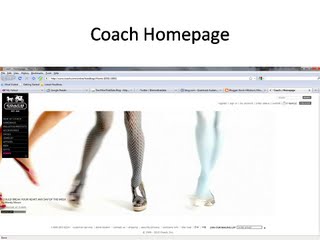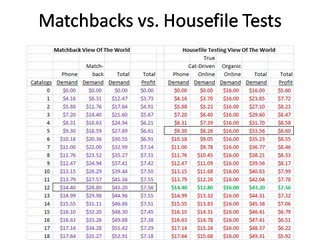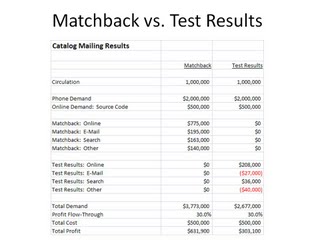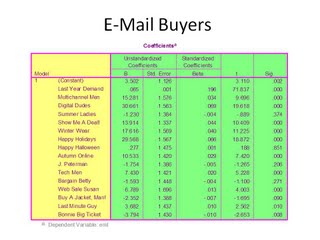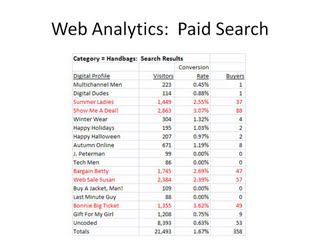MAJOR ADVERTISING ANNOUNCEMENT
April 1, 2010 (April Fools Day): Major Consumer Support Vendors Announce Integration Alliance Designed To Enhance Consumer Experiences Across Multiple Channels And Platforms
Executives from six brands today announced an alliance that is expected to revolutionize the way that consumers and brands interact with each other.
The forward-thinking alliance includes leading organizations like Abacus, the offline data compilation organization; Coremetrics, the online data compilation measurement firm; Twitter, the iconic text messaging platform; Quad Graphics, a leading print vendor; Clear Channel, the dominant player in the FM radio business, and SpotXChange, the video re-targeting service.
The alliance, code-named "Harmony", will provide integrated multi-channel solutions to brands hoping to capitalize on the emerging world of what Abacus Vice President of Innovation Lyle Cartryte called "360 degree brand immersion".
Mr. Cartryte continued ... "By combining data, traditional media platforms, and social media, we have the ability to capture both offline and online customer interactions, and then create personalized advertising messages designed to better monetize the customer experience across vendor platforms! In particular, we'll be able to merge our offline data with online data culled from clients who use Coremetrics so that we have a 360 degree view of customer purchase activity, something that is very important to online brands given that 90% of purchases still happen in the antiquated, outdated, unpopular, and inefficient offline world of retail. By integrating offline, online, and social media interactions via Twitter, we believe we'll know more about your spouse than you know. If your spouse buys you flowers on February 13 in an offline retail environment, we will be able to use retargeting technologies from SpotXchange to offer your spouse the opportunity to purchase chocolates, make dinner reservations, or fill prescriptions, all of which significantly benefit you, the loving spouse while creating monetization opportunities for brands participating in 'Harmony'. Best of all, the alliance allows us to use print technology from Quad Graphics to deliver personalized, relevant, anticipated print-based messages, reminding your spouse that Easter is just around the corner. And if your spouse fails to buy an Easter ham, we can use Twitter to target this individual with relevant and anticipated tweets from trusted brands like Safeway. Just imagine a tweet from @safeway that says something like '@dude, OMG, WTH, you forgot to buy a ham, do you want one delivered to your home today?' And then on Easter Sunday, when your spouse tweets to his 37 followers that he forgot to pick up stuffing, we can use video-based retargeting technology to reach this consumer. Honestly, 'Harmony' represents the future of marketing, a beautiful future if I may be so bold. This is the unrealized promise of CRM. Traditional marketing is dead."
Kyle Larson, Vice President of Product Development and Synergies at Twitter, lamented the fact that 'Harmony' represents tight integration between various vendors and Twitter, but celebrated the fact that "... we're finally going to be compensated for our efforts ... seriously compensated!"
EVP Linton Pendleton of Clear Channel, a radio conglomerate and "Harmony" brand partner, believes that FM radio technology will be very complementary to "Harmony", especially when Hologram Marketing becomes a reality in 2014.
Mr. Pendleton said "... we plan on using the 'Jack FM' voice, known and beloved by radio listeners as 'Jack', to be the voice of the Hologram that will eventually deliver advertising messages to consumers via Holograms transmitted via FM radio waves. Listeners know that on 'Jack' radio stations, we 'play what we want'. Consumers will soon learn that in this advertising network called 'Harmony', we will 'advertise what we want', while building an infrastructure that allows us to use offline, online, and social media activity to target highly relevant ads to engaged consumers. It isn't far fetched to think that we can achieve our goal of having a mobile Hologram appear just above your left eye maybe seven dozen times a day, within your line of sight, using the voice of 'Jack' from 'Jack FM' to communicate brand-relevant messages like 'You appear tired, could I access your debit card and have a five hour energy drink delivered to your cubicle ... advertising what we want, Jack FM'. Then, after a suitable "latency period" elapses, like two minutes, the hologram would reappear in a non-obtrusive manner, saying something like 'People who recently tweeted about being hungry and who shopped at a QFC grocery store in the past week love getting coupons in the mail for carryout Chinese food from Safeway. Would you like for me to send you coupons via the mail and then access your debit card so that I can deliver hot 'n sour soup to your cubicle right now to satisfy your hunger, or would you prefer a Snickers Bar? ... advertising what we want, Jack FM ... this message was brought to you by Q13 Fox, where tonight you should watch the next episode of '24' because Jack Bauer discovers a terrorist plot, one where his very television series is canceled, causing him to want to blow up the FCC if his show is truly canceled. That's '24', tonight on Q13 Fox'. As you can see, we will be able to use integrated data across channels, platforms, and technology, to deliver highly relevant and anticipated brand messages that enrich the lives of many consumers via beloved Hologram marketing icons bearing the voice of 'Jack' from 'Jack FM'. And the experience will be fully personalized. You will be able to decide if the hologram appears above your left eye, above your right eye, or right in front of your face. You will be able to adjust the volume of Jack's voice. You will be able to decide if 'Jack' has dark hair, blonde hair, or a simple buzz cut. It's really going to be something! Think about all of the authentic social media conversations that we will be able to analyze, segment, and convert into highly personalized, non-obtrusive brand messages via Hologram marketing?"
Financial details were not disclosed. The transaction is expected to close today, April 1.
Labels: April Fools Day
